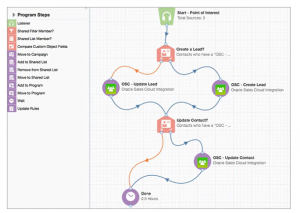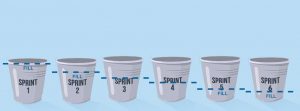In a world crunched for time, speed is the ultimate competitive advantage. It’s why a small, lean startup with little cash can compete with (and sometimes replace) established corporations with seemingly unlimited resources.
Everyone is starting to realize this, yet examples of organizational drag still pop up in every industry. Our government, for instance, is an inefficient bureaucracy designed to slow the rate of change and ensure stability. We see this every time we step into a Department of Motor Vehicles or engage with the Internal Revenue Service.
A slowed rate of new product development, operational inefficiency, lower employee engagement, and customer dissatisfaction are all byproducts of slow-moving bureaucracies. The resulting stagnation inevitably affects bottom lines and the customer experience — and in an experience-obsessed reality, businesses will then need to scramble to improve.
Enter Design Thinking
Design has become an integrated business function because it drives innovation and new product development. Large corporations have realized this, developing powerful internal experience and customer-centric design organizations to try to keep pace. What corporations have long understood is that design isn’t cheap or easy, which is why it has often been outsourced. But that’s changing.
Design thinking — a user-centric approach to problem-solving championed by organizations like IDEO, IBM, and Google — has increasingly been deployed within larger corporations to tear down silos, drive innovation, and shift focus from bureaucracy to providing solutions for customers.
IDEO’s Tim Brown defined design thinking’s role in business as “a discipline that uses the designer’s sensibility and methods to match people’s needs with what is technologically feasible and what a viable business strategy can convert into customer value and market opportunity.”
Design thinking practitioners have since adopted countless variations of this definition. But another way of understanding the approach’s influence is to think about its absence. The absence of design thinking leads to decisions by committees, solutions molded by opinion rather than data, and the collective anxiety of executives with goals but not strategies — not the best solution for businesses wanting to prioritize speed.
Crawl, Walk, Sprint
Design thinking’s primary vehicle is the sprint, which generally consists of small, well-defined stages. Sprints typically involve multidisciplinary teams, exercises meant to stimulate idea generation, and an emphasis on progress over perfection.
Versions of design thinking exist within companies all over the world. But one company that has been especially successful in its application of the approach is (surprise!) Google.
The Google design sprint is a highly optimized model based on many types of design activities and collaborative strategies. There’s nothing new inside it, but the way the activities are orchestrated is truly innovative. Google examined which processes could diminish the inevitable lag in product development, amplified them, and created universal parameters to ensure effective communication throughout the sprint.
In my own company, we’ve emulated Google’s method with remarkable results and have helped other organizations do the same. The reality is that any group tackling a complex challenge can utilize this approach, though it takes continual practice to master.
Sprints and speed go hand in hand. Ideas are generated rapidly, voted on collectively, and transformed into prototypes with urgency. Again, progress is more important than perfection, so we can collectively watch ideas evolve. The sprint is also incredibly effective at removing the debate from collaborative design activities — this is where so many large firms fall short.
We apply the sprint to every kind of problem. The folks at Google Ventures even encourage you to try using a sprint to order lunch, which we did (once). It’s simply a decision-making framework that focuses on finding the right idea, then iteratively improving that idea to direct the development of a tangible product.
The sprint is effectively unbiased by the group, but it places the burden of decision-making onto a single decision maker. If that sounds undemocratic, it’s because it is. And that’s the incredible power of the sprint — it exploits a group’s power to generate ideas and an individual’s ability to select them. Once that has been established, you see immediate and accelerated progress.
Lacing Up Your Sprint Shoes
The sprint isn’t magic — it’s just a method. But like anything, it takes practice to really get good at it. If you’re trying it for yourself, here are some actions you can take now:
1. Learn from the masters.
You can download “The Sprint Book” or buy the print copy. It takes only two hours to read (and I’m a terribly slow reader). Don’t worry if the activities don’t all add up right away: Focus on the five-day process, what it can deliver, and what your team should look like.
2. Build your team . . .
This is the single most important step you can think about. Building your team isn’t about who has the longest résumé or the most experience — it’s about who is willing to fearlessly contribute.
Look to young innovators and risk-takers in your firm. They’ve got big ideas. Sprints will help you capture and deliver those. And keep in mind that when sprinting with a client, you won’t need more than four people from your team, including yourself. Any more than that leads to inefficiency.
3. . . . Or partner up.
Not every business will be ready to jump into its own sprint team. Corporations often build powerful internal design groups, but they’re tasked with incremental improvements and can’t escape the gravity of performance goals. That’s not great for speed, but partner firms can help here.
The first step is engaging with your design partner and jumping into a sprint — without worrying about the outcome. Design sprints should be inexpensive investments that yield valuable and tested results. Once you have engaged in two or three sprints with your partner, you’ll be ready to run your own.
4. Work hard; rest up.
Sprints require hands-on participation. Leaders owe it to themselves, their shareholders, and their customers to focus. Block off four hours a day for five days and show up ready to focus. If you’re not in the room, sprints won’t work.
And sprints might be short, but they’re work-intensive. Don’t forget to reward your team (and yourself) for all the work put in.
5. Get some air.
Take your team outside the office for a sprint. Off-site sprinting resets your perspective and makes it easier to see beyond everyday presumptions. This also makes it easier for the team to focus on the sprint without getting distracted by daily responsibilities. Book a retreat, take your team, meet your design partner, and build the next big thing.
Now more than ever, speed is crucial — if there’s someone else out there solving the same problem you are and doing it faster, whom will consumers flock to? Drop the weight of bureaucratic operations, and get ready to sprint.
Business & Finance Articles on Business 2 Community(55)
Report Post





